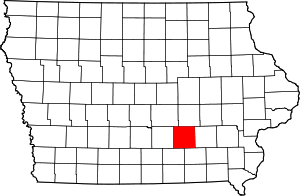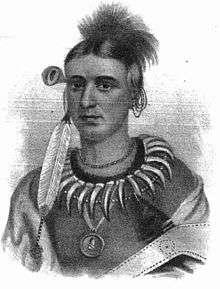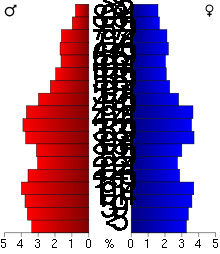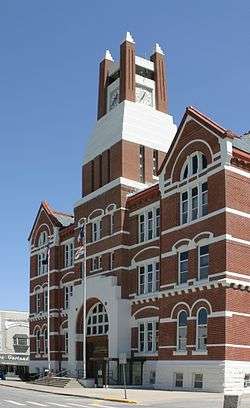Mahaska County, Iowa
| Mahaska County, Iowa | |
|---|---|
|
| |
 Location in the state of Iowa | |
 Iowa's location in the U.S. | |
| Founded | 1843 |
| Named for | Mahaska |
| Seat | Oskaloosa |
| Largest city | Oskaloosa |
| Area | |
| • Total | 573 sq mi (1,484 km2) |
| • Land | 571 sq mi (1,479 km2) |
| • Water | 2.5 sq mi (6 km2), 0.4% |
| Population | |
| • (2010) | 22,381 |
| • Density | 39/sq mi (15/km²) |
| Congressional district | 2nd |
| Time zone | Central: UTC-6/-5 |
| Website |
www |
Mahaska County is a county located in the U.S. state of Iowa. As of the 2010 census, the population was 22,335.[1] The county seat is Oskaloosa.[2]
Mahaska County comprises the Oskaloosa, IA Micropolitan Statistical Area.
History

Mahaska County was formed on February 17, 1843. The county has been self-governing since February 5, 1844. It was named after Chief Mahaska of the Iowa tribe. The county was the first in Iowa to have a sheriff and a justice of peace.[3]
The first courthouse was completed in January, 1846. The second structure was put into use on February 27, 1886. The first school, a small log cabin one-half mile (ca. 2 km) east of Oskaloosa, was opened on September 16, 1844 and the Cumberland Presbyterian Church opened as the first church in 1846.[4] On July 2, 1850, the first edition of the Iowa Herald was issued (today the Oskaloosa Herald). In 1864, the first tracks were laid through the county of the Des Moines Valley Railroad.[3]
Coal mining was once a major industry in Mahaska County.[5] In the 19th century, Muchakinock, about 5 miles (8.0 km) south of Oskaloosa, was probably the largest and most prosperous coal camp in Iowa.
Geography
According to the U.S. Census Bureau, the county has a total area of 573 square miles (1,480 km2), of which 571 square miles (1,480 km2) is land and 2.5 square miles (6.5 km2) (0.4%) is water.[6]
Major highways
Adjacent counties
- Jasper County (northwest)
- Poweshiek County (north)
- Keokuk County (east)
- Wapello County (southeast)
- Monroe County (southwest)
- Marion County (west)
Demographics
| Historical population | |||
|---|---|---|---|
| Census | Pop. | %± | |
| 1850 | 5,989 | — | |
| 1860 | 14,816 | 147.4% | |
| 1870 | 22,508 | 51.9% | |
| 1880 | 25,202 | 12.0% | |
| 1890 | 28,805 | 14.3% | |
| 1900 | 34,273 | 19.0% | |
| 1910 | 29,860 | −12.9% | |
| 1920 | 26,270 | −12.0% | |
| 1930 | 25,804 | −1.8% | |
| 1940 | 26,485 | 2.6% | |
| 1950 | 24,672 | −6.8% | |
| 1960 | 23,602 | −4.3% | |
| 1970 | 22,177 | −6.0% | |
| 1980 | 22,867 | 3.1% | |
| 1990 | 21,532 | −5.8% | |
| 2000 | 22,335 | 3.7% | |
| 2010 | 22,381 | 0.2% | |
| Est. 2014 | 22,370 | [7] | 0.0% |
| U.S. Decennial Census[8] 1790-1960[9] 1900-1990[10] 1990-2000[11] 2010-2013[1] | |||
2010 census
The 2010 census recorded a population of 22,381 in the county, with a population density of 39.2051/sq mi (15.1372/km2). There were 9,766 housing units, of which 8,975 were occupied.[12]
2000 census

As of the census[13] of 2000, there were 22,335 people, 8,880 households, and 6,144 families residing in the county. The population density was 39 people per square mile (15/km²). There were 9,551 housing units at an average density of 17 per square mile (6/km²). The racial makeup of the county was 97.20% White, 0.64% Black or African American, 0.19% Native American, 0.86% Asian, 0.03% Pacific Islander, 0.30% from other races, and 0.78% from two or more races. 0.85% of the population were Hispanic or Latino of any race.
There were 8,880 households out of which 32.40% had children under the age of 18 living with them, 58.60% were married couples living together, 7.50% had a female householder with no husband present, and 30.80% were non-families. 26.60% of all households were made up of individuals and 12.40% had someone living alone who was 65 years of age or older. The average household size was 2.45 and the average family size was 2.96.
In the county the population was spread out with 25.70% under the age of 18, 9.40% from 18 to 24, 26.80% from 25 to 44, 21.70% from 45 to 64, and 16.30% who were 65 years of age or older. The median age was 37 years. For every 100 females there were 99.10 males. For every 100 females age 18 and over, there were 96.90 males.
The median income for a household in the county was $37,314, and the median income for a family was $43,557. Males had a median income of $32,618 versus $23,192 for females. The per capita income for the county was $18,232. About 7.50% of families and 9.80% of the population were below the poverty line, including 11.70% of those under age 18 and 9.30% of those age 65 or over.
Communities
Cities
Unincorporated communities
See also
References
- 1 2 "State & County QuickFacts". United States Census Bureau. Retrieved July 20, 2014.
- ↑ "Find a County". National Association of Counties. Retrieved 2011-06-07.
- 1 2 Mahaska County
- ↑ About Mahaska
- ↑ Map of Historic Coal Mines in Mahaska County, Mahaska 4-H Tech Team, May 2006.
- ↑ "US Gazetteer files: 2010, 2000, and 1990". United States Census Bureau. 2011-02-12. Retrieved 2011-04-23.
- ↑ "Annual Estimates of the Resident Population for Incorporated Places: April 1, 2010 to July 1, 2014". Retrieved June 4, 2015.
- ↑ "U.S. Decennial Census". United States Census Bureau. Retrieved July 20, 2014.
- ↑ "Historical Census Browser". University of Virginia Library. Retrieved July 20, 2014.
- ↑ "Population of Counties by Decennial Census: 1900 to 1990". United States Census Bureau. Retrieved July 20, 2014.
- ↑ "Census 2000 PHC-T-4. Ranking Tables for Counties: 1990 and 2000" (PDF). United States Census Bureau. Retrieved July 20, 2014.
- ↑ "Population & Housing Occupancy Status 2010". United States Census Bureau American FactFinder. Retrieved May 23, 2011.
- ↑ "American FactFinder". United States Census Bureau. Retrieved 2008-01-31.
External links
| Wikimedia Commons has media related to Mahaska County, Iowa. |
 |
Jasper County | Poweshiek County |  | |
| Marion County | |
Keokuk County | ||
| ||||
| | ||||
| Monroe County | Wapello County |
| |||||||||||||||||||||
Coordinates: 41°20′02″N 92°38′44″W / 41.33389°N 92.64556°W
